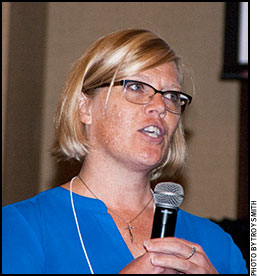Carcass Quality Starts In Utero
Fetal programming plays a role in carcass quality.
 Kim Vonnahme, professor at North Dakota State University, defined fetal programming as the in vitro environment that leads to a successful animal pregnancy. Speaking Aug. 30 at the Applied Reproductive Strategies in Beef Cattle (ARSBC) symposium in Manhattan, Kan., she outlined what it takes to reach the animal’s full genetic potential for carcass quality from the fetal phase.
Kim Vonnahme, professor at North Dakota State University, defined fetal programming as the in vitro environment that leads to a successful animal pregnancy. Speaking Aug. 30 at the Applied Reproductive Strategies in Beef Cattle (ARSBC) symposium in Manhattan, Kan., she outlined what it takes to reach the animal’s full genetic potential for carcass quality from the fetal phase.
“A classic animal breeding example is phenotype plus genotype plus environment,” Vonnahme said. “An animal can’t reach [its] genetic potential for carcass quality if the uterine environment is suboptimal.”
Fetal programming occurs naturally, she continued. It takes place when a stimulus or insult establishes a permanent response in the uterus. The developmental programming hypothesis outlines how an animal is housed in a mother’s uterus can predict how it will grow and be after it’s born.

“It is really important for producers to understand the function of the placenta,” said Kim Vonnahme, professor at North Dakota State University. “We can provide the mothers help with nutrient transportation across the placenta tissue.”
“What happens in the development phase is what will program an animal for later in life,” she said. “Timing is everything when we look at stressors or restrictors in pregnancies. It all depends on when the restriction occurs.”
The placenta plays a key role in fetal programming, she explained. No matter what livestock species — whether cattle, sheep or swine — from conception to consumption, livestock spend 25%-55% of their lifetime being nourished by the placenta.
“It is really important for producers to understand the function of the placenta,” Vonnahme said. “We can provide the mothers help with nutrient transportation across the placenta tissue.”
After Day 45 of the pregnancy, organ systems are going to overcompensate if the cow encounters any type of stress, she explained. The fetus will compensate in order to change its physiological state to survive its time in the uterus. Those same tendencies will continue when the animal is born.
Early pregnancy issues can be compensated for later in the life of the animal, she said. Mid-pregnancy issues of restriction or stress can lead to reduced weaning weights, reduced carcass weights and decreased beef tenderness.
By looking at the epigenetics of the animal, one can study which genes have been “turned on” or which genes “are not to be read.”
“We are not changing the genotypes of the animal at all,” she continued, “but we can change which genes are being read or not based on what the mother has [eaten] or experienced in her pregnancy.”
It is vital to the animal’s productivity to understand the different periods of vulnerability during development. When looking at fetal growth and development, Vonnahme said most of the growth occurs in the later one-third of pregnancy.
Timing of supplementation is important to meet the metabolic demands of the dam. The demands could change, and so should the supplementation times, she explained. When looking at carcass information from research studies, Vonnahme said it didn’t matter what type of system the cow was in, but what really mattered was that the mothers received a protein supplement that lasted throughout the last one-third of the pregnancy.
The heifer calves whose mothers were given the consistent protein supplement had greater fertility and pregnancy rates than the heifer calves whose mothers didn’t have a protein supplement. Her team discovered that blood flow is increased in cows given protein supplements, which leads to healthier programmed calves.
Vonnahme spoke during Wednesday’s ARSBC session focused on systems and health. Visit the Newsroom at www.appliedreprostrategies.com, which features comprehensive coverage of the symposium, to view her PowerPoint, to read the proceedings or to listen to the presentation. Compiled by the Angus Journal editorial team, the site is made possible through sponsorship by the Beef Reproduction Task Force. To access video of the presentations, visit the Beef Reproduction Task Force page on Facebook.
The 2017 ARSBC Symposium was hosted by the Task Force and Kansas State University Research & Extension. Next year’s symposium will be Aug. 29-30 in Ruidoso, N.M.

Editor’s Note: Katy Holdener is the digital content manager for the American Angus Association.






